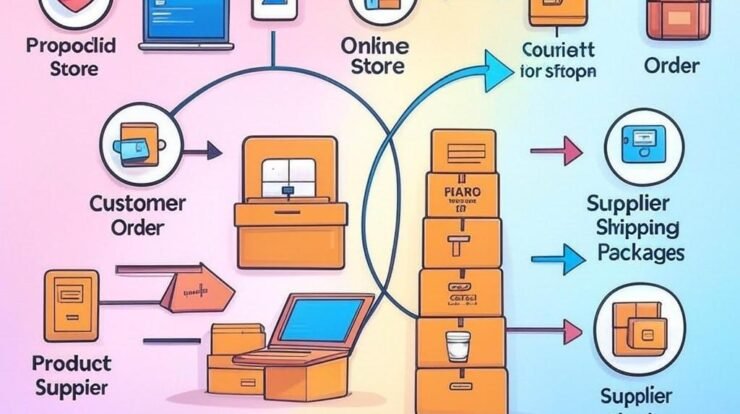Starting a business from home has always felt like a dream to me—a way to break free from the 9-to-5 grind, take control of my time, and build something that’s truly mine. Over the years, I’ve dabbled in side hustles, watched friends launch their own ventures, and read countless stories of people turning their passions into profit. What I’ve learned is that the most profitable businesses to start from home aren’t just about chasing trends—they’re about finding the right fit for your skills, lifestyle, and goals. In this post, I’m sharing my take on some of the best home-based business ideas that can deliver real financial rewards, along with insights from my own journey and practical tips to get you started.
—
Why Start a Business from Home?

There’s something deeply empowering about running a business from your own space. No commute, no office politics, just you and your vision. But beyond the freedom, home-based businesses are appealing because they often require low startup costs and can scale quickly with the right strategy. Whether you’re a stay-at-home parent, a corporate escapee, or someone looking to diversify your income, the opportunities are vast. The rise of digital tools, e-commerce platforms, and remote work has made it easier than ever to launch a profitable venture from your living room.
I remember when I first considered working from home. I was skeptical—could I really make a living without a “real” office? But the numbers don’t lie. According to recent studies, over 50% of small businesses in the U.S. are home-based, and many of them generate six-figure incomes. That’s when I realized the potential wasn’t just hype—it was real. Let’s dive into some of the most lucrative home-based businesses you can start today, along with why they work and how to make them your own.
—
1. E-Commerce: Selling Products Online
When I think of home-based businesses with massive potential, e-commerce always comes to mind. The ability to sell products online—whether through your own website, Amazon, or Etsy—has transformed countless lives. From handmade crafts to drop-shipped gadgets, the possibilities are endless.
Why It’s Profitable
The global e-commerce market is projected to hit $6 trillion by 2026, and you don’t need a huge budget to grab a slice of that pie. Platforms like Shopify and WooCommerce make it easy to set up a store, while drop-shipping models let you sell without holding inventory. I’ve seen friends start with as little as $500 and scale to $10,000 a month in revenue within a year by finding the right niche.
My Experience
A couple of years ago, I helped a friend launch an Etsy shop selling custom pet accessories. We spent evenings brainstorming designs, researching competitors, and tweaking product listings. The first sale felt like winning the lottery! What made it work was her passion for pets and a knack for spotting trends (think personalized dog bandanas). Today, she’s quit her day job and runs the shop full-time.
How to Get Started
Choose a niche: Focus on something you’re passionate about, like eco-friendly home goods or vintage clothing. Research demand using tools like Google Trends or Amazon’s Best Sellers.
Set up your store: Platforms like Shopify ($29/month) or Etsy (listing fees start at $0.20) are beginner-friendly.
Market smart: Use Instagram and Pinterest to showcase your products. I’ve found that short, engaging videos perform best for driving traffic.
Pro Tip: Optimize your product listings with keywords like “handmade jewelry” or “organic skincare” to boost visibility. It’s a small step that can make a big difference.
—
Read more: Ultimate Affiliate AI review – A Comprehensive Insight
2. Freelance Services: Turning Skills into Income

If you’ve got a skill—writing, graphic design, coding, or even social media management—you can turn it into a thriving home-based business. Freelancing is one of the most profitable businesses to start from home because it leverages what you already know, with minimal upfront costs.
Why It’s Profitable
Businesses are outsourcing more than ever, and freelancers are in high demand. Sites like Upwork and Fiverr report that top freelancers in fields like copywriting or web development can earn $50-$150 per hour. Even part-time, that adds up fast.
My Experience
I started freelancing as a content writer while working a full-time job. My first gig was writing blog posts for a small travel agency, and I was shocked at how quickly I could earn $200-$300 a week on the side. What I loved most was the flexibility—I could work from my couch at 10 p.m. or during a lunch break. Eventually, I built a portfolio that landed bigger clients, and now freelancing is my main income source.
How to Get Started
Identify your skills: Are you great at editing videos, designing logos, or managing ad campaigns? List your strengths and match them to market needs.
Build a portfolio: Create a simple website using Wix or Squarespace to showcase your work. Include testimonials if possible.
Find clients: Join platforms like Upwork, Freelancer, or LinkedIn. Networking in niche Facebook groups can also lead to gigs.
Pro Tip: Don’t undervalue your services. I made the mistake of charging too little early on, which attracted low-budget clients. Research industry rates and price yourself competitively.
—
3. Online Courses and Coaching: Sharing Your Expertise
There’s something incredibly rewarding about teaching others what you know, and it’s also one of the most lucrative home-based businesses out there. Whether you’re an expert in fitness, photography, or personal finance, you can create online courses or offer coaching services that generate passive income.
Why It’s Profitable
The e-learning market is booming, with platforms like Udemy and Teachable hosting millions of students. A well-designed course priced at $100 can earn thousands over time, especially if you market it effectively. Coaching, meanwhile, can command $100-$500 per session for high-demand niches.
My Experience
Last year, I took a leap and created a mini-course on time management for freelancers. I used Teachable (free plan to start) and recorded videos on my laptop. It wasn’t perfect, but the feedback was incredible—students loved the practical tips. Within six months, the course had earned me $2,000, and I’m still getting sales with zero extra work.
How to Get Started
Pick a topic: Choose something you’re knowledgeable about and that has demand. Tools like AnswerThePublic can help you find popular questions in your niche.
Create content: Use simple tools like Canva for visuals and Zoom for recordings. You don’t need fancy equipment.
Market your course: Share snippets on YouTube or TikTok to attract students. Email marketing (via Mailchimp) is also a game-changer.
Pro Tip: Offer a free webinar or ebook to build trust and funnel people to your paid offerings. It’s a strategy that’s worked wonders for me.
—
Read more: Unlock Your Potential – The Ultimate Online Earning Website for Students
4. Content Creation: Building a Brand Online
Blogging, YouTube, podcasts, or TikTok—content creation is a powerful way to build a home-based business. It’s not just about going viral; it’s about creating value that keeps people coming back.
Why It’s Profitable
Successful content creators can earn through ads, sponsorships, affiliate marketing, or selling their own products. Top bloggers report earning $5,000-$50,000 a month, while YouTubers with 100,000 subscribers can make $1,000-$5,000 per video through ad revenue alone.
My Experience
I started a blog about productivity hacks a few years ago, mostly as a creative outlet. I didn’t expect much, but after consistently posting for a year, I started earning affiliate income from recommending tools like Trello and Notion. It’s not millions, but an extra $500 a month from something I love feels like a win.
How to Get Started
Choose your platform: Blogs are great for SEO, while YouTube and TikTok offer faster audience growth. Pick one and stick with it.
Create quality content: Invest in a decent microphone or camera if you’re doing video. For blogs, focus on long-form posts (like this one!) that answer specific questions.
Monetize early: Join affiliate programs like Amazon Associates or sign up for ad networks like Google AdSense once you have traffic.
Pro Tip: Consistency is key. I committed to posting weekly, even when I had zero readers. Over time, the audience grew, and so did the income.
—
5. Virtual Assistance: Supporting Businesses Remotely
If you’re organized and love helping others, becoming a virtual assistant (VA) is one of the best home-based businesses to start. VAs handle tasks like email management, scheduling, or social media for busy entrepreneurs and companies.
Why It’s Profitable
The demand for VAs is skyrocketing as businesses shift online. Entry-level VAs earn $15-$25 per hour, but specialized skills (like email marketing or bookkeeping) can push rates to $50/hour or more.
My Experience
A friend of mine started as a VA after being laid off during the pandemic. She took a $200 course on VA skills, landed her first client through a Facebook group, and within three months was earning $3,000 a month working 20 hours a week. Watching her thrive inspired me to explore similar opportunities.
How to Get Started
Learn the basics: Free resources on YouTube or affordable courses on Udemy can teach you the ropes.
Find clients: Check job boards like Indeed or join VA-specific groups on Facebook. Pitch directly to small businesses in your network.
Specialize: Offering niche services (e.g., Pinterest management) sets you apart and boosts your rates.
Pro Tip: Create a professional LinkedIn profile to attract higher-paying clients. It’s a small investment that pays off.
—
Read more: Top 10 Proven Ways to Make Real Money Online – Start Earning Today!
Tips for Success in Any Home-Based Business
No matter which path you choose, a few principles can make or break your success. Here’s what I’ve learned from my own wins and failures:
Start small, but think big: You don’t need a perfect plan to begin. Launch with what you have and improve as you go.
Invest in learning: Spend time (and sometimes money) on courses, books, or mentors to sharpen your skills.
Network relentlessly: Join online communities, attend virtual events, and connect with others in your niche. Collaboration often leads to opportunities.
Track your progress: Use tools like Google Analytics or QuickBooks to monitor your growth and finances. Data keeps you grounded.
—
The Emotional Side of Starting a Home-Based Business
I’d be lying if I said this journey is all smooth sailing. There are days when self-doubt creeps in, when sales are slow, or when you wonder if you’re cut out for this. But there’s also an unmatched thrill in seeing your first sale, getting a glowing client review, or realizing you’ve built something from scratch. For me, the freedom to work on my terms and the chance to turn my passions into profit outweigh the challenges.
When I started, I was terrified of failing. What if no one bought my services? What if I couldn’t figure out the tech? But every successful entrepreneur I’ve met has the same story: they started scared but kept going. That’s the secret. You don’t need to be fearless—you just need to take the next step.
—
Final Thoughts: Which Business Will You Start?
The most profitable businesses to start from home all have one thing in common: they align with your strengths and the market’s needs. Whether it’s selling products online, freelancing, teaching, creating content, or supporting other businesses, there’s a path for you. My advice? Pick one idea, commit to learning, and take action today. Even a small step—like setting up a Shopify store or posting your first blog—can set you on the path to financial freedom.
What’s holding you back? For me, it was fear of not being “ready.” But the truth is, you’ll never feel fully ready—you just have to start. So, grab a notebook, jot down your ideas, and let’s build something amazing together. Which of these businesses sparks your interest? Drop a comment or shoot me a message—I’d love to hear your story.





